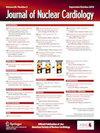Single-photon emission computed tomography/computed tomography quantification of Tc-99m pyrophosphate uptake to assess tafamidis treatment response in transthyretin cardiac amyloidosis
IF 3
4区 医学
Q2 CARDIAC & CARDIOVASCULAR SYSTEMS
引用次数: 0
Abstract
Background
Cardiac imaging with bone-avid tracers for the diagnosis of transthyretin amyloid (ATTR) cardiac amyloidosis uses only limited quantification, but single-photon emission computed tomography/computed tomography (SPECT/CT) acquisition can provide volumetric assessment with quantification of tracer uptake. Tafamidis is routinely used in the treatment of cardiac amyloidosis, but there are scant data on changes in imaging results during therapy. The purpose of this study was to perform a longitudinal assessment of Tc-99m-pyrophosphate (PYP) imaging to determine if tafamidis therapy results in any change in quantitative measures of tracer uptake.
Methods
The study incorporated a prospective, single-center study of ATTR patients being treated with tafamidis using Tc-99m-PYP SPECT/CT to quantify cardiac tracer uptake in the whole heart and left ventricle. Standardized uptake values (SUVs) were adjusted for blood pool activity. Comparison of baseline activity was made to values obtained approximately every 6 months during treatment.
Results
Twenty-two patients (77.0 ± 7.5 years old, 86.4% male) were on tafamidis for 15.3 ± 4.0 months, with an average time between baseline and final follow-up study of 16.8 ± 4.7 months. Thirteen patients (59.1%) had multiple follow-up amyloid studies. Statistically significant reductions in total SUVs, SUV volume, and percentage of injected dose were seen. Adjusted for the maximal aortic SUV, the total SUV in the left ventricle decreased by 36.9%, the SUV volume by 38.7%, and the percentage of injected dose decreased by 34.9% (all P values ≤ 0.0001). Over the study duration, there was a decrease of 7.7%/month in the measured metrics.
Conclusion
The quantitative SUV measurements from Tc-99m-PYP SPECT/CT revealed an overall decrease in scintographic amyloid burden during the course of tafamidis therapy, but additional work is needed to determine the optimal metrics and improve the reproducibility of the quantification.
SPECT/CT量化99m-TCPYP摄取量以评估ATTR心脏淀粉样变性的塔法米迪治疗反应
背景:使用骨惰性示踪剂诊断 ATTR 心脏淀粉样变性只采用了有限的量化方法,但 SPECT/CT 采集可提供容积评估,并对示踪剂摄取进行量化。他法米迪是治疗心脏淀粉样变性的常规药物,但有关治疗过程中成像结果变化的数据却很少。本研究的目的是对 Tc-99m-PYP 成像进行纵向评估,以确定他法米迪治疗是否会导致示踪剂摄取的定量测量发生任何变化:这是一项前瞻性单中心研究,研究对象为接受他法米迪治疗的ATTR患者,使用Tc-99m-PYP SPECT/CT定量检测整个心脏和左心室的示踪剂摄取量。标准化摄取值(SUV)根据血池活性进行了调整。将基线活性与治疗期间大约每 6 个月获得的值进行比较:22名患者(77.0±7.5岁,86.4%为男性)接受了15.3±4.0个月的他法米迪治疗,从基线到最终随访研究的平均时间为16.8±4.7个月。13人(59.1%)进行了多次淀粉样蛋白随访研究。总 SUV、SUV 容量和注射剂量百分比均有统计学意义的明显降低。根据最大主动脉 SUV 调整后,左心室总 SUV 下降了 36.9%,SUV 容量下降了 38.7%,注射剂量百分比下降了 34.9%(所有 p 值均小于 0.0001)。在研究期间,测量指标每月下降7.7%:Tc-99m-PYP SPECT/CT的SUV定量测量结果显示,在他法米迪治疗过程中,淀粉样蛋白负荷总体下降,但还需要进一步研究,以确定最佳指标,并提高定量的可重复性。
本文章由计算机程序翻译,如有差异,请以英文原文为准。
求助全文
约1分钟内获得全文
求助全文
来源期刊
CiteScore
5.30
自引率
20.80%
发文量
249
审稿时长
4-8 weeks
期刊介绍:
Journal of Nuclear Cardiology is the only journal in the world devoted to this dynamic and growing subspecialty. Physicians and technologists value the Journal not only for its peer-reviewed articles, but also for its timely discussions about the current and future role of nuclear cardiology. Original articles address all aspects of nuclear cardiology, including interpretation, diagnosis, imaging equipment, and use of radiopharmaceuticals. As the official publication of the American Society of Nuclear Cardiology, the Journal also brings readers the latest information emerging from the Society''s task forces and publishes guidelines and position papers as they are adopted.

 求助内容:
求助内容: 应助结果提醒方式:
应助结果提醒方式:


